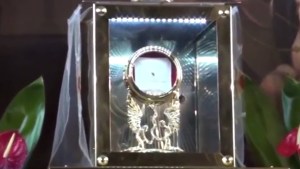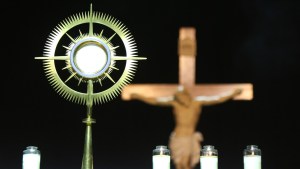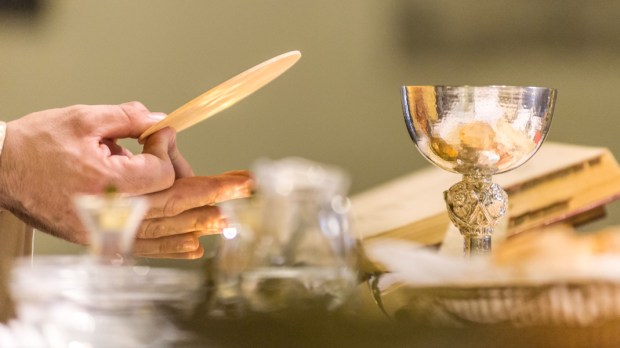In the Catholic Church, the Eucharist is not simply a re-presentation of the bread and wine Jesus blessed at the Last Supper, but is the real presence of Jesus Christ under the appearances of bread and wine.

Read more:
4 Amazing Eucharistic miracles from the last 20 years
Once you understand this basic teaching of the Catholic Church, all of the various customs and traditions that Catholics have at Mass make much more sense.
Here are 5 such Eucharistic traditions that are seen at Mass and their spiritual meaning.
Why did Jesus choose bread and wine for the Eucharist?
The primary reason why God chose bread and wine was connected to his previous revelations in the Old Testament and how he was preparing his people for this moment in history.
In the Old Covenant bread and wine were offered in sacrifice among the first fruits of the earth as a sign of grateful acknowledgment to the Creator. But they also received a new significance in the context of the Exodus: the unleavened bread that Israel eats every year at Passover commemorates the haste of the departure that liberated them from Egypt; the remembrance of the manna in the desert will always recall to Israel that it lives by the bread of the Word of God; their daily bread is the fruit of the promised land, the pledge of God’s faithfulness to his promises. The “cup of blessing” at the end of the Jewish Passover meal adds to the festive joy of wine an eschatological dimension: the messianic expectation of the rebuilding of Jerusalem. When Jesus instituted the Eucharist, he gave a new and definitive meaning to the blessing of the bread and the cup. (CCC 1334)
God always knew he would use bread and wine, so he began preparing the people of Israel for this revelations gradually over time. The Old Testament is full of symbolic precursors, making Jesus’ actions at the Last Supper a very fitting fulfillment of what had already taken place.
Why do Catholics genuflect in a church?
Historically speaking, the act of genuflecting on one knee comes from court etiquette and was done while in the presence of a medieval king or noble. It was a sign of respect as well as a pledge of service.
Christians adopted this custom over time, and it became fully integrated into the liturgy of the Roman Rite by the 16th century. The left knee was always used to give reverence to a king, and so to distinguish the Christian usage of the custom, Christians would genuflect in church on the right knee to God.
God has always been known to Jews and Christians as a king who is rich in mercy and boundless in love. To give honor to that “King of Love,” Christians thought it fitting to pay respect and honor to him by genuflecting every time they entered his “court.”
This meant bending on one knee whenever they passed in front of the tabernacle — the little house in every Catholic church that holds the Blessed Sacrament.
For Catholics we believe that Jesus is truly present, Body, Blood, soul and divinity in the Holy Eucharist, and when we genuflect, we do so because we are in God’s presence.
What is a tabernacle?
The Catechism further explains the history of the tabernacle and how “the tabernacle was first intended for the reservation of the Eucharist in a worthy place so that it could be brought to the sick and those absent outside of Mass. As faith in the real presence of Christ in his Eucharist deepened, the Church became conscious of the meaning of silent adoration of the Lord present under the Eucharistic species. It is for this reason that the tabernacle should be located in an especially worthy place in the church and should be constructed in such a way that it emphasizes and manifests the truth of the real presence of Christ in the Blessed Sacrament.” (1379).
Why do priests drop a piece of host into the chalice?
According to Nikolaus Gihr in the book The Holy Sacrifice of the Mass, the action of placing a small particle of the host into the chalice has roots in the Early Church and a custom that was meant to signify unity with the pope and local bishop.
Participation in the same Holy Sacrifice was regarded as a sign and pledge of ecclesiastical Communion; mutually to prove and maintain this, Popes and bishops sent to other bishops, or priests too, parts of Consecrated Hosts, which the recipients dropped into the chalice and consumed …This custom existed in Rome until about the ninth century. There the Pope on Sundays and feast-days sent to those priests who had charge of Divine service at the churches within the city, the Eucharist as a symbol of communion with the ecclesiastical Head, and as a sign that they were empowered to celebrate.
It was a visible and concrete reminder that they were united to the pope and bishops each time they celebrated the Mass.
The spiritual reason chalices are made from precious metal
While it’s true that Jesus likely used a humble clay cup at the Last Supper, similar to what is found in the film Indiana Jones and the Last Crusade, the chalice used at Mass is not meant to be a direct imitation of that first chalice.
Christopher Carstens explains in his book Mystical Body, Mystical Voice: Encountering Christ in the Words of the Masshow the Mass is more a heavenly banquet than a re-enactment of an ordinary Passover meal.
Does it matter that Christ may not have used a “precious chalice” at the Last Supper? That he used a chalice is imperative for the Church and her re-presentation of his sacrifice; and while it may be that the chalice was not outwardly precious, it was made precious by its contents. For while the Mass and its Eucharistic prayer hearken back to actions of Christ in the upper room some two thousand years ago, that historical action currently exists in heavenly splendor, which is why it can be made present to us at all. The cup of the first Paschal meal in time is now furnished with divine splendors and is “the chalice of great joy, of the true feast, for which we all long,” and it is this divine chalice that our sacramental chalice emulates.

Read more:
How I began to believe that the Eucharist really is Jesus

